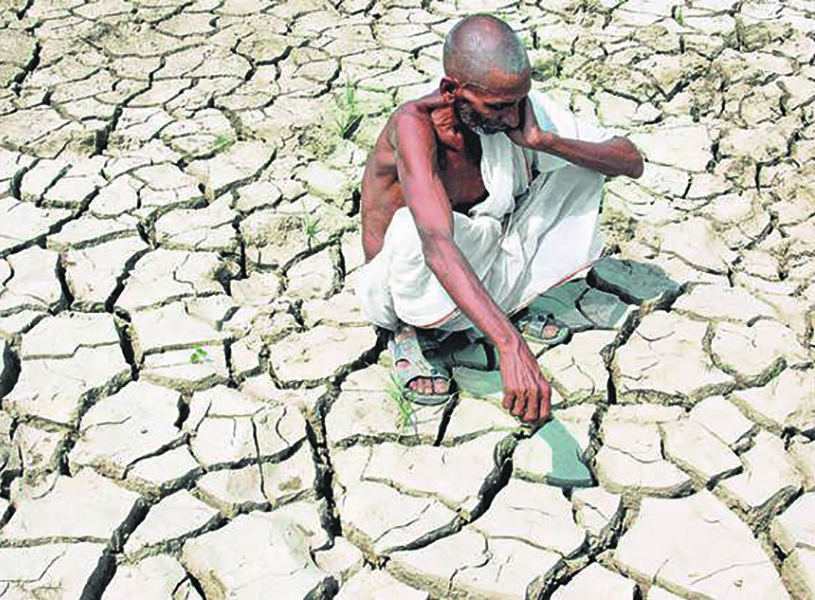Liberalization of Indian economy that started in 1990s, has impacted Indian agriculture fundamentally. One after the other, Maharashtra, Karnataka, Andhra Pradesh, Punjab, Madhya Pradesh and Chattisgarh fell victim to globalised economic laws jeopardizing lives of local farmers. And now Rajasthan has joined the list. Import of crops, increasing farming costs, falling profits and mounting loans have converted the ‘dreams around liberalization’ into nightmares, as far as the farmers are concerned. A GroundXero Report from Jaipur.
Today, Mangalram Meghwal – a physically challenged farmer in his thirties, living in Charanwas village, Nagaur district, Rajasthan – would have lost his land to a bank auction – if he was alive, that is. Meghwal hanged himself at his residence on the night of 4th August after receiving the notification from the bank. The district secretary informed the press that there was a KCC of Rs. 2,98,000 in his name, out of which he had repaid Rs. 1,95,000; yet it turned Non Performing Asset (NPA) following which he was issued land auction notices.
According to a BBC report published in 2013, between 1995 and 2011, approximately 2.7 lakh farmers had committed suicide in India. In the state of Maharashtra alone, where farmers were assumed to be comparatively affluent, the number of farmer suicides has exceeded 50,000. This shows how far Indian economy has pushed its farmers. This dire state of victimization however has also led to organized demonstrations of farmers’ outrage at the broken promises and criminal mismanagement of the agriculture sector. Initially the protests were mainly led by farmers in Maharashtra, Tamilnadu, Chattisgarh and Madhya Pradesh but now farmers from Rajasthan have joined in. In Madhya Pradesh the state government attempted to crush these movements at gunpoint and six farmers were shot to death. Soon afterwards, farmers from Rajasthan also started organizing actively. As in Maharashtra, here too the All India Kisan Sabha played an important role in organizing this movement.
The reasons underlying the farmers’ movement
Burden of loans, anti-farmer laws, adverse climatic conditions and low market prices for crops have broken the backs of the Rajasthan farmers over the years. Farmers belonging to Shekhawati regions (semi-arid north-eastern parts of the state, falling under the Thar desert) such as Hanumangarh, Ganganagar, Sikar, Jhujhunu and Churu came forward asking for their rights and joined protest marches. In most parts of Hanumangarh and Sri Ganganagar, the land is watered by canals or tube-wells. This is also the region that was severely affected by the techniques implemented in neighboring Punjab and Haryana in the name of Green Revolution. Forcing the farmers to sow hybrid, genetically modified (GM) seed varieties and water-intensive crops in the name of higher yield, together with excessive use of chemical fertilizers and insecticides, have ruined both the land and the farmers alike. While earlier the farmers used to save a part of their crops in order to accumulate seeds for the next sowing season, the hybrid GM seeds need to be purchased every year, and at a very high price. For example, a 450g packet of BT Narma (cotton) is priced at Rs. 900 approximately. Due to shortage of supply, farmers have to purchase it from the black market for a price as high as Rs. 2500 per packet. Chemical fertilizers, insecticides and excessive requirement of water further add to the farming expenses. The price they get for 1 quintal of the crop however is not more than Rs. 4000.
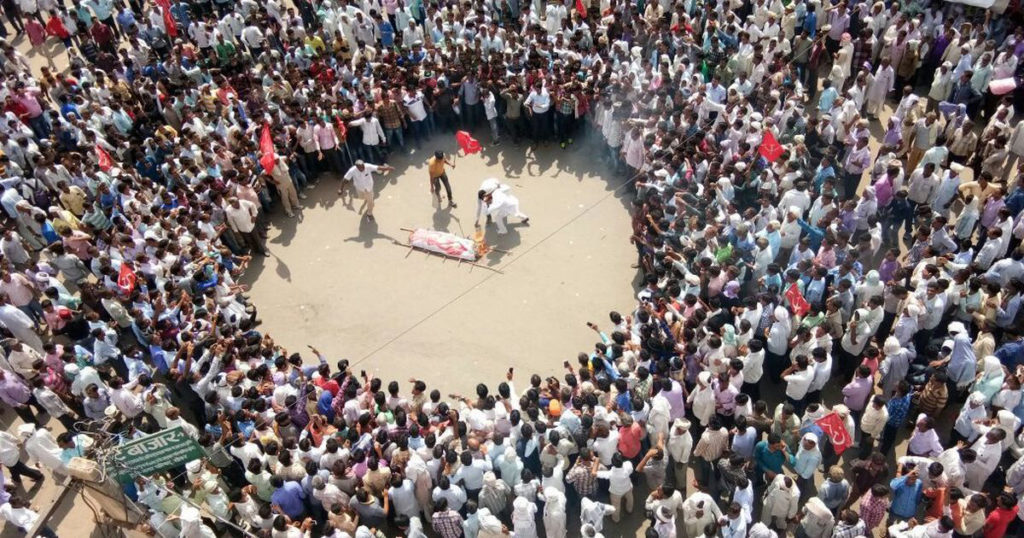
Rajasthan farmers’ movement. Source: The Scroll
It is clear that in reality these ‘improved’ techniques have nothing to do with improving the condition of the farming land or better production. Rather, they are implemented for ensuring increasing profits for multinational agro-companies. For the past few years this situation has turned disastrous in terms of the Indian farmers’ livelihood. Shortage of canal water, erratic rains and hence gradual drop in groundwater levels have made sowing of these water-intensive crops an unaffordable business. The farmers are forced to take loan from banks to cope with the situation. However, bank loans are far from adequate compared to the actual expenses, which in turn forces the farmers to borrow from the local moneylenders (Sahukaars). The landless and marginal farmers are in any case not considered eligible for bank loans, so they have no other choice but to depend on private lenders for loans at high interest rates. They are unable to repay the loans they take; nor do they get fair price for the crops they produce. If the weather turns adverse, their condition turns fatal. The farmer gets forever tangled in a web of loans for each and every basic need in his/her life such as farming expenses, children’s education, marriage and other family functions, treatment of the sick and so on. Once this web starts closing in, the farmer is unable to find a way-out and chooses to commit suicide.
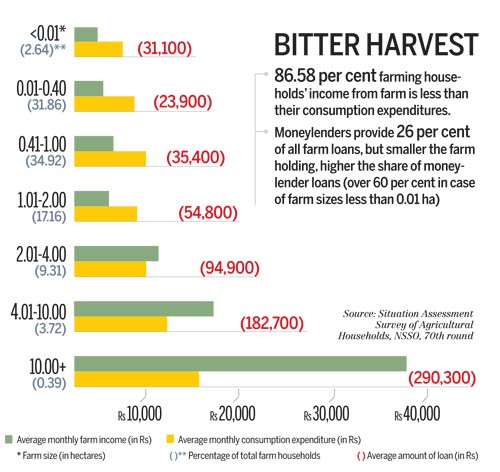
Source: Indpedia
In 2013, NSSO conducted a national survey of income, expense, property and loans for Indian farmers. 3309 farmers from 214 villages in Rajasthan were part of the sample. According to the report, whereas 52% of Indian farmers are under the burden of loan from one source or another (a 3.6% increase since 2003), the figure is as high as 61.8% in Rajasthan alone. At an all-India level, on an average, a farmer was found to be earning Rs. 6426 per month, while having to spend Rs. 6223 for consumption needs – with a mere Rs. 203 left for savings or other expenditure. The farce named Green Revolution is being performed over the dead-bodies of Indian farmers, whereas multinationals such as Monsanto are looting all the profits from Indian agricultural sector.
One more important factor
Deserts cover over 60% of Rajasthan’s lands. Those desert lands that have access to water are also used as grazing grounds for domestic animals – breeding livestock being one of the significant sources of livelihood for people in this state. It is this region where the farmers’ movements are the most prominent. Just as farming, breeding livestock, which used to be a key source of earning for the landless and marginal farmers, has gradually become riskier. Earlier, during adverse seasons, selling milk could act at least as a partial backup source of income. Now, even milk is severely under-priced in the market. The Dairy Sangh buys cow-milk from a rural milk-seller for just Rs. 16 per liter. During the last few years under BJP rule, glorification of cow as a ‘holy and sacred’ animal to the Hindus has adversely affected dairy business; terrorization of prospective sellers of calves by Gau-Rakshaks has led to not only a depression in the animal meat-product market, but also the dairy market. Government has put a ban on selling animals, causing steady increase in the number of stray cows and calves. The farmers now have to find means to save their crops from these animals, on top of their mounting financial misery. They are forced to run profitless cow-sheds for their own animals as well as the stray ones. This comes as one of the many effects of the fundamentalist ideology of Hindutva propagated by the ruling BJP government that has put Muslim and Dalit lives at stakes. Interestingly, under the Modi Government, India has become the largest exporter of beef in the world, with the biggest Indian beef-merchants being Brahmins and other upper caste businesspersons.
This cow-terrorism has taken livestock breeding completely out of the hands of small farmers, and this issue is now very much an important part of the farmers’ agenda in Rajasthan. Many women have joined the movement as well, due to this specific reason. In Sikar for example, a large number of women blocked the road during the peak harvest season.
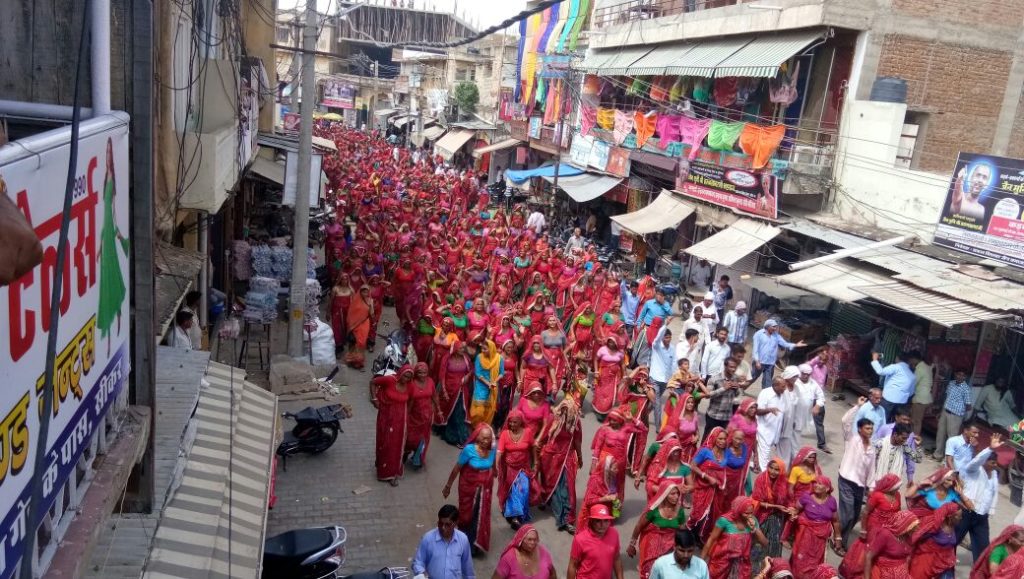
Women’s rally in Sikar. Source: Newsclick
The Sikar DJ Sound Union, Auto Rickshaw Union, students and the youth, employees of educational institutes and even the urban small traders stood in support of the farmers, as the economy of this region is primarily agriculture-based.
A glimpse of the farmers’ movement: strengths and weaknesses
The farmers’ movement under the All India Kisan Sabha (CPIM’s farmers’ wing) has certain notable weaknesses as well. The principal demand of the movement has been farm loan waiver, whereas the demands of the small and landless farmers were not given adequate priority by the movement’s leadership. The only farmers eligible for loan waiver are those who took loans through an organized process, such as nationalized banks or from other governmental agencies, and mostly comprise of middle and rich farmers. The demands of small and landless farmers were not given importance in the movement agendas. Demands of the livestock breeders were not paid heed to as well. The fact that the farmer leaders were ready to retreat from the struggle right after Raje Government announced loan waivers of up to a mere Rs. 50,000, makes one suspicious about the extent of their true concerns for the farmers as against their concern for upcoming state elections. The CPI(M) farmers’ wing seemed to be more interested in sowing the seeds of their own electoral success rather than intensifying the farmers’ struggle.
The demands of farmers’ movement in Rajasthan were the following:
- The entire amount of loan taken by the farmers from banks and the Sahkari Samitis have to be waived.
- The recommendations of Swaminathan Aayog are to be implemented – especially in terms of determining the Minimum Support Price based on the formula of 1.5 times the input costs.
- Farmers aged above 60 are to be given a monthly pension of Rs. 5,000.
- Reduction in the amount of loans obtainable from the Sahkari Samitis has to be stopped.
- Ban on selling calves is to be lifted.
- The issue of stray animals – mainly cows and calves – has to be resolved.
- Livestock breeders and traders must be provided safety (from Gau Rakshaks).
- General ban on selling of animals is to be lifted
- Toll roads are to be made free for the farmers.
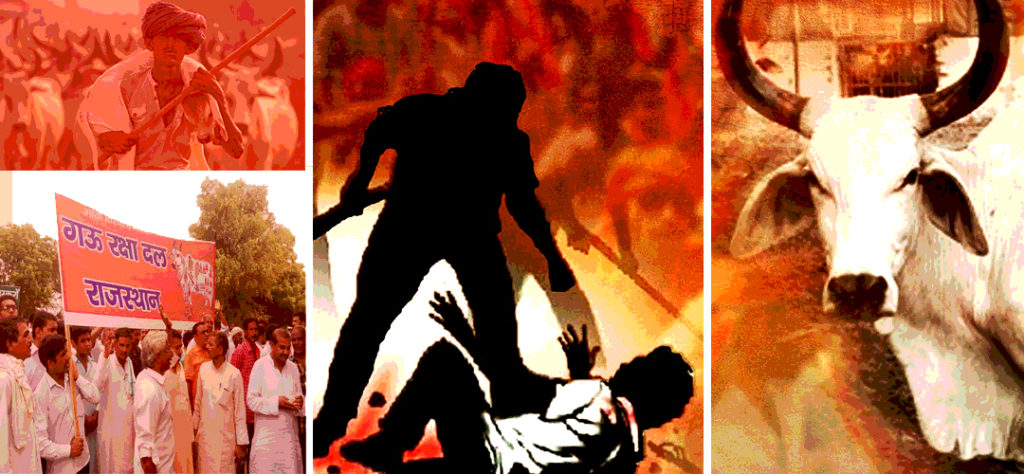
Gau Raksha Atrocities
Last year on 16 June, Rajasthan farmers blocked the National Highway for three hours. On 17 July, road blocks took place in several towns. on 9 August, the farmers courted arrest across every district headquarter and subdivision office in Rajasthan. The movement became more intense with time. On 1 September, during the second phase of the movement, the farmers gheraoed the DC office, but the government was still not ready to hear them out. Hence, on 11 September, the protesting farmers were forced to take to the roads and block a Mega Highway. On 13 September, the government agreed to have a dialogue with farmer leaders and an agreement was reached in the form of loan waivers of up to Rs. 50,000. But this was not duly implemented. The farmers intensified their movement with such fervor that the government had to take recourse to arresting the top leaders. On 22 February 2018, once again the National Highway was blocked and a farmers rally to Jaipur was announced, forcing the government to release the movement leaders. On 6 March, a supplementary budget was passed in the state Assembly and the Chief Minister implemented the Rs. 50,000 loan waiver. The farmers were also granted insurance claims on crops damaged by adverse weather conditions.
On one hand, this was a major victory. The resolution came as a ray of hope for the farmers crushed under heavy burdens of loan. On the other hand, as we mentioned earlier, the misery of the landless and the marginal farmers, who committed suicides in the largest of numbers and also constitute the majority of Indian farmers, were far from addressed. Their problems run much deeper than their inability to take credit from organized sources such as banks and other agencies due to non-possession of agricultural land as guarantee.
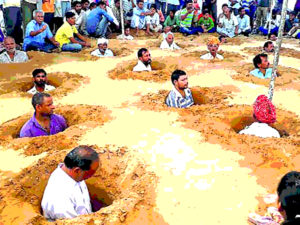
Farmers in Jaipur. Source: IE
The landless and marginal farmers constitute more than 80% of the entire Indian farming community. Firstly, they are dependent on local moneylenders for getting crop loans at high-interest rates. Secondly, the lands can no more be tilled by hand-ploughs with the help of camels. Farming equipments like tractors and threshing machines are to be rented from big farmers and these are usually unaffordable for the small land holding peasant. Even the water for irrigating lands has to be bought from the big farmers. Thus, the expenses keep mounting. The artificially depressed crop output prices in the market become the last nail in the coffin. For example, onion, which should be priced at Rs. 10 per kg, is being sold at Rs. 2 per kg. Same goes for other vegetables such as potato, tomato etc. During April-May 2018, seven farmers from Kota, Bundi, Jhalawar and Hadoti have committed suicide. The Hadoti farmers in particular are not even getting a price as low as Rs. 2 per kg for garlic, which is to be ideally priced within a range of Rs. 40 to Rs. 140, or even higher.
Between 1 and 10 June 2018, 130 farmers’ organizations (excluding the BJP’s farmers’ wing) called for a Gaon Bandh movement. As part of this movement, Rajasthan farmers stopped sending milk and vegetables to the cities. The demands included implementation of the Swaminathan Committee recommendation of fixing the crop price at one and half times the farming expenses. Ganganagar, Hanumangarh, Churu and Sikar districts were affected by this movement. In some places, milk and vegetables were thrown on the road as a form of protest. But due to the weak leadership, this movement did not go very far. In some places, it ended even before 10 June.
The landless and marginal farmers are now abandoning farming and are being increasingly forced to work as daily-wage laborers. It was only the middle and big farmers who gained from this movement. The most oppressed section with the direst of needs was systematically left out.
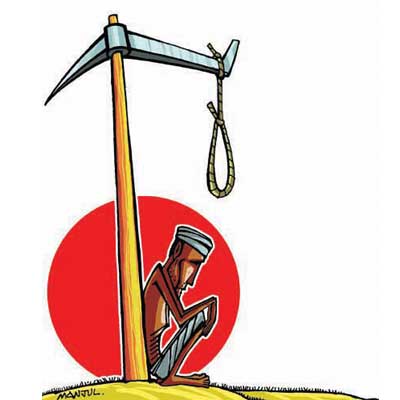
Source: DNA India

